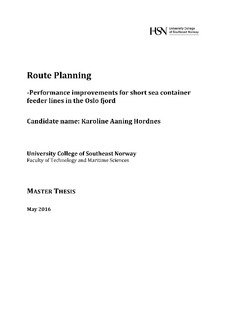Route Planning: Performance improvements for short sea container feeder lines in the Oslo fjord
Master thesis
Permanent lenke
http://hdl.handle.net/11250/2420152Utgivelsesdato
2016Metadata
Vis full innførselSamlinger
Sammendrag
In this study the focus will be on the short sea container feeder lines in the area of the Oslo fjord and its ports, and how to make it more competitive against other modes of transport. This was tested by looking at the already planned and running routes that have regular port calls in the seven ports of the Oslo fjord, and improving them in two scenarios. In the scenarios three factors where changed: time in port, transit time and the average speed on the sea legs. For calculating the port times and transit times in the two scenarios, a benchmark approach was used. The scenario results were looked at with the use of three parameters for making sea transport a more attractive choice of transport: lead time, cost and flexibility. This showed that with the improvements the sea transport can become a more attractive mode of transport. The findings show that the feeder lines can reduce their route trip time, with the improvements in the three factors. However, there might be some weaknesses in the benchmark approach for some of the studied routes. This is because the benchmarked port times, might be out of reach for some of the port calls.
